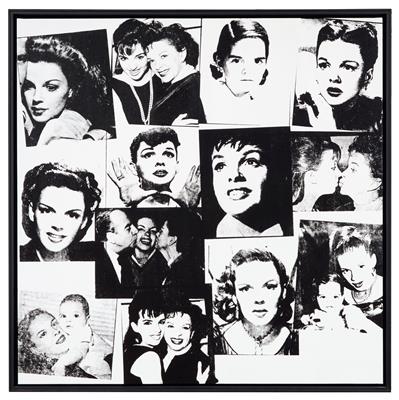Andy Warhol

(Pittsburgh 1928–1987 New York)
Judy Garland and Liza Minelli,1978, stamped with the Estate of Andy Warhol, stamps and numbered PO50.770 on the overlap, synthetic polymer and silkscreen ink on canvas, 101.5 x 101.5 cm, framed
The work is registered in the Andy Warhol Foundation for the Visual Arts, Inc. and is accompanied by a certificate dated 6 March 2002 (available in photocopy)
Provenance:
The Estate of Andy Warhol and the Andy Warhol Foundation for the Visual Arts, Inc., New York
Sperone Westwater, New York Galleria Cardi & Co., Milan European Private Collection (acquired from the above by the present owner in 2002)
Exhibited:
Tokyo, Museum of Contemporary Art; Fukoka Art Museum and Kobe, Hyogo Prefectural Museum of Modern Art, Andy Warhol 1956–86. Mirrors of His Time, April-November 1996,
exh. cat. p. 153, no. 183, with ill.
Rome, Andy Warhol: pentiti e non peccare piu!-Repent and sin no more!, Chiostro del Bramante, 29 September 2006-7 January 2007, exh. cat. no. 62, p. 113 with ill.
Literature:
J. O’Connor and Benjamin Liu, Unseen Warhol, Milan 1996, p. 110 (red version illustrated)
The Andy Warhol Museum, Andy Warhol: 365 Takes, New York 2004, pp. 297–298, with ill.
Note:
There are only two other paintings in existence: one is black and red and one is a multicolour version donated by the artist to Liza Minelli
In an era in which the media have induced a progressive erosion of privacy leading to its ultimate destruction, and in which the cult of beauty has become ever stronger, Warhol (as a man of his time) understands that in this context photography can help to identify and define oneself. “Beauties in photographs are different from beauties in person. It must be hard to be a model, because you’d want to be like the photograph of you, and you can’t ever look that way. And so you start to copy the photograph.”Andy Warhol, The Philosophy of Andy Warhol: From A to B and Back Again, Harvest Book, New York, p. 63
Pop Art certainly owes a debt to the media system and, in particular, to photography which is merged into diverse aspects of the poetry of Pop. From Warhol’s use of limitless repetition of originals to Lichtenstein’s and Oldenburg’s zoomed-in and blown-up comic strips and objects. These artists appropriated a fundamental characteristic of the medium of photography: the possibility of alienating one’s perception of the world through decontextualisation, proximity and enlargement.
Warhol was, moreover, himself an avid photographer and tireless chronicler of his life and his encounters; from the 1960s until the end he carried his Polaroid camera with him everywhere, collecting snap-shots with it of friends, lovers, famous people and of himself.
The evocative power of his images is undeniable and the reference to the concept of icons in his work is unavoidable. Nonetheless, while “the medieval images constitute a link with the otherworldly and therefore do not depict reality but have an exclusively symbolic value, the images created by Warhol derive from photographic portraits that most often have been almost worn out by media abuse”. G. Mercurio, Andy Warhol. Pentiti e non peccare più!, Skira, Milan 2006, p. 59.
Linked to the artist by a profound bond of friendship, Liza Minnelli was a recurring protagonist in Warhol’s work and he depicted her countless times over the course of his career. The first was in 1977 in his Polaroid Portraits where she wears a T-shirt with the words “New York”.
Judy Garland, on the other hand, was different. She never posed for the artist, but he nonetheless created several portraits of her, including the famous one from 1985 in which the star is dressed in a sumptuous fur and accompanied by the slogan “What becomes a legend most?”
In this black and white family collage Warhol creates an album of photos that celebrate public and private moments in the lives of the two stars. With its black and white colour scheme and its assemblage of photographs of Judy and Liza in different periods of their lives, Judy Garland and Liza Minnelli 1978, appears different from the artist’s other works. Although it was created using the same technique as many other works – transferring the photographic image onto a canvas or other support and sometimes modifying it through graphic or pictorial interventions – this work emanates a warmth and familial feeling that are not normally associated with Warhol’s art.
“Warhol’s cult of celebrity seems to leave space for this tender bond with his fascinating subjects.”
Expert: Alessandro Rizzi
 Alessandro Rizzi
Alessandro Rizzi
+39-02-303 52 41
alessandro.rizzi@dorotheum.it
05.06.2019 - 17:00
- Dosažená cena: **
-
EUR 479.100,-
- Odhadní cena:
-
EUR 280.000,- do EUR 420.000,-
Andy Warhol
(Pittsburgh 1928–1987 New York)
Judy Garland and Liza Minelli,1978, stamped with the Estate of Andy Warhol, stamps and numbered PO50.770 on the overlap, synthetic polymer and silkscreen ink on canvas, 101.5 x 101.5 cm, framed
The work is registered in the Andy Warhol Foundation for the Visual Arts, Inc. and is accompanied by a certificate dated 6 March 2002 (available in photocopy)
Provenance:
The Estate of Andy Warhol and the Andy Warhol Foundation for the Visual Arts, Inc., New York
Sperone Westwater, New York Galleria Cardi & Co., Milan European Private Collection (acquired from the above by the present owner in 2002)
Exhibited:
Tokyo, Museum of Contemporary Art; Fukoka Art Museum and Kobe, Hyogo Prefectural Museum of Modern Art, Andy Warhol 1956–86. Mirrors of His Time, April-November 1996,
exh. cat. p. 153, no. 183, with ill.
Rome, Andy Warhol: pentiti e non peccare piu!-Repent and sin no more!, Chiostro del Bramante, 29 September 2006-7 January 2007, exh. cat. no. 62, p. 113 with ill.
Literature:
J. O’Connor and Benjamin Liu, Unseen Warhol, Milan 1996, p. 110 (red version illustrated)
The Andy Warhol Museum, Andy Warhol: 365 Takes, New York 2004, pp. 297–298, with ill.
Note:
There are only two other paintings in existence: one is black and red and one is a multicolour version donated by the artist to Liza Minelli
In an era in which the media have induced a progressive erosion of privacy leading to its ultimate destruction, and in which the cult of beauty has become ever stronger, Warhol (as a man of his time) understands that in this context photography can help to identify and define oneself. “Beauties in photographs are different from beauties in person. It must be hard to be a model, because you’d want to be like the photograph of you, and you can’t ever look that way. And so you start to copy the photograph.”Andy Warhol, The Philosophy of Andy Warhol: From A to B and Back Again, Harvest Book, New York, p. 63
Pop Art certainly owes a debt to the media system and, in particular, to photography which is merged into diverse aspects of the poetry of Pop. From Warhol’s use of limitless repetition of originals to Lichtenstein’s and Oldenburg’s zoomed-in and blown-up comic strips and objects. These artists appropriated a fundamental characteristic of the medium of photography: the possibility of alienating one’s perception of the world through decontextualisation, proximity and enlargement.
Warhol was, moreover, himself an avid photographer and tireless chronicler of his life and his encounters; from the 1960s until the end he carried his Polaroid camera with him everywhere, collecting snap-shots with it of friends, lovers, famous people and of himself.
The evocative power of his images is undeniable and the reference to the concept of icons in his work is unavoidable. Nonetheless, while “the medieval images constitute a link with the otherworldly and therefore do not depict reality but have an exclusively symbolic value, the images created by Warhol derive from photographic portraits that most often have been almost worn out by media abuse”. G. Mercurio, Andy Warhol. Pentiti e non peccare più!, Skira, Milan 2006, p. 59.
Linked to the artist by a profound bond of friendship, Liza Minnelli was a recurring protagonist in Warhol’s work and he depicted her countless times over the course of his career. The first was in 1977 in his Polaroid Portraits where she wears a T-shirt with the words “New York”.
Judy Garland, on the other hand, was different. She never posed for the artist, but he nonetheless created several portraits of her, including the famous one from 1985 in which the star is dressed in a sumptuous fur and accompanied by the slogan “What becomes a legend most?”
In this black and white family collage Warhol creates an album of photos that celebrate public and private moments in the lives of the two stars. With its black and white colour scheme and its assemblage of photographs of Judy and Liza in different periods of their lives, Judy Garland and Liza Minnelli 1978, appears different from the artist’s other works. Although it was created using the same technique as many other works – transferring the photographic image onto a canvas or other support and sometimes modifying it through graphic or pictorial interventions – this work emanates a warmth and familial feeling that are not normally associated with Warhol’s art.
“Warhol’s cult of celebrity seems to leave space for this tender bond with his fascinating subjects.”
Expert: Alessandro Rizzi
 Alessandro Rizzi
Alessandro Rizzi
+39-02-303 52 41
alessandro.rizzi@dorotheum.it
|
Horká linka kupujících
Po-Pá: 10.00 - 17.00
kundendienst@dorotheum.at +43 1 515 60 200 |
| Aukce: | Post-War and Contemporary Art I |
| Typ aukce: | Salónní aukce |
| Datum: | 05.06.2019 - 17:00 |
| Místo konání aukce: | Wien | Palais Dorotheum |
| Prohlídka: | 25.05. - 05.06.2019 |
** Kupní cena vč. poplatku kupujícího a DPH
Není již možné podávat příkazy ke koupi přes internet. Aukce se právě připravuje resp. byla již uskutečněna.
Další objekty umělce
-

Odhadní cena:
EUR 6.000,- do EUR 10.000,- -

Nach/after Andy Warhol, 10 Bilder:
Vyvolávací cena:
EUR 2.000,- -

Odhadní cena:
EUR 1.500,- do EUR 2.500,-
Všechny objekty umělce
